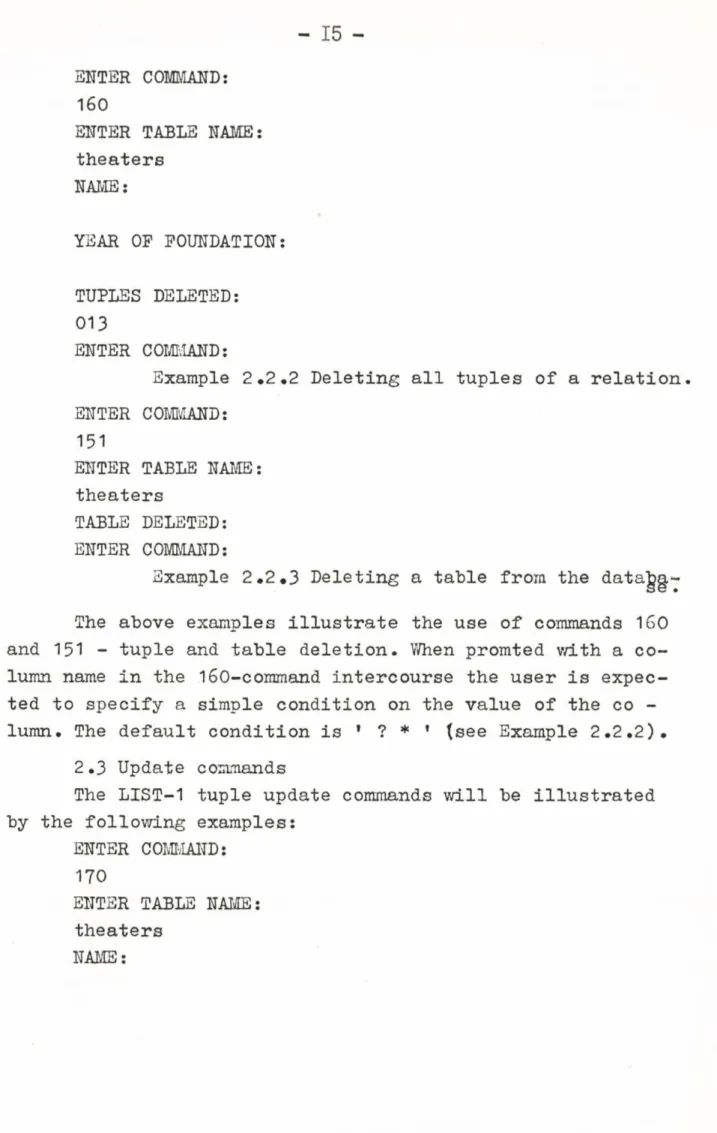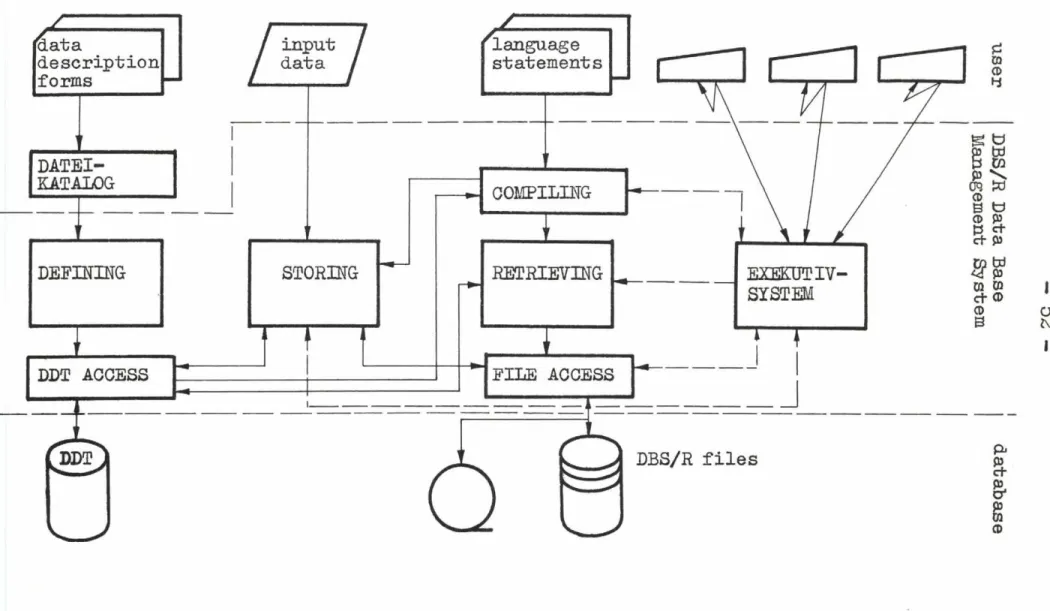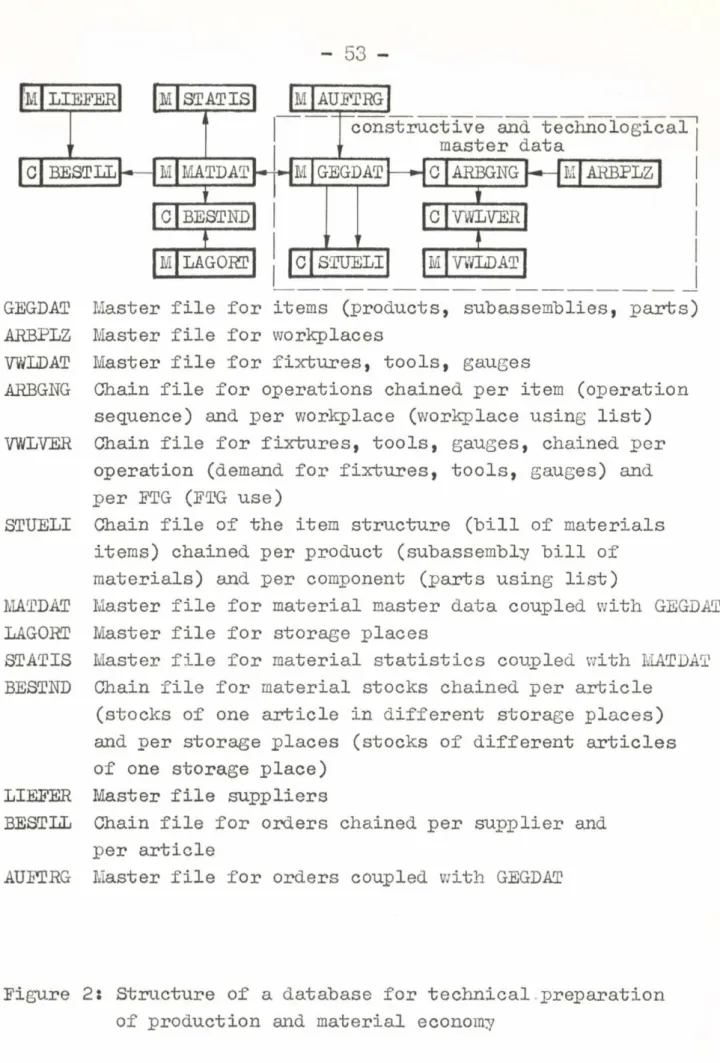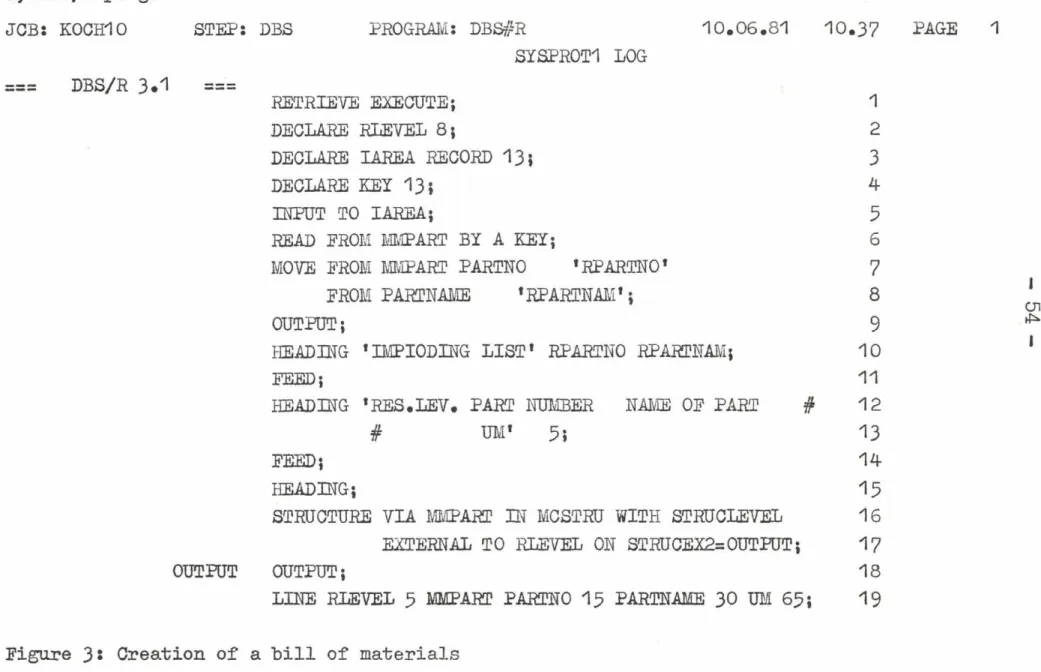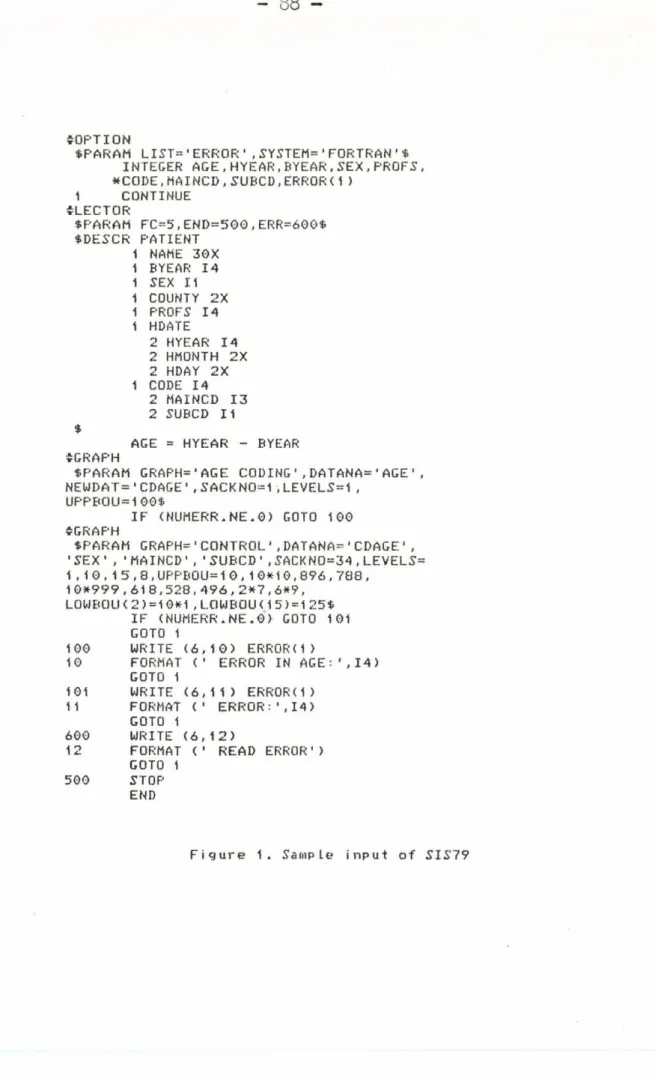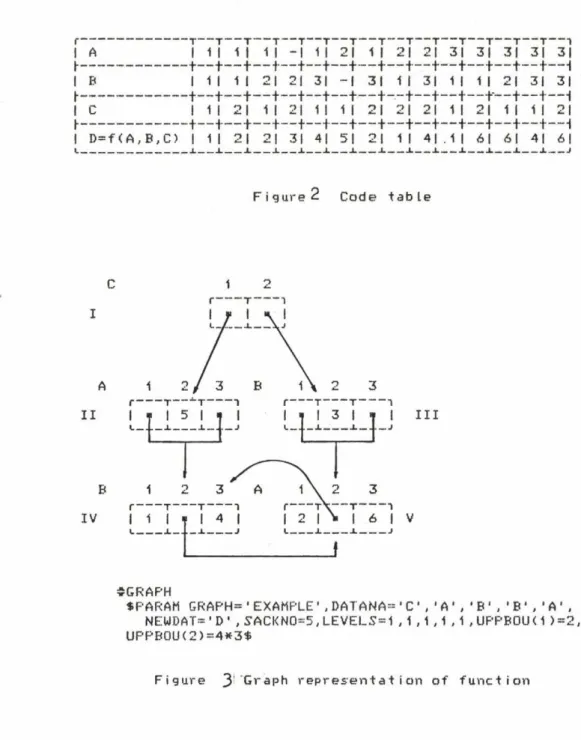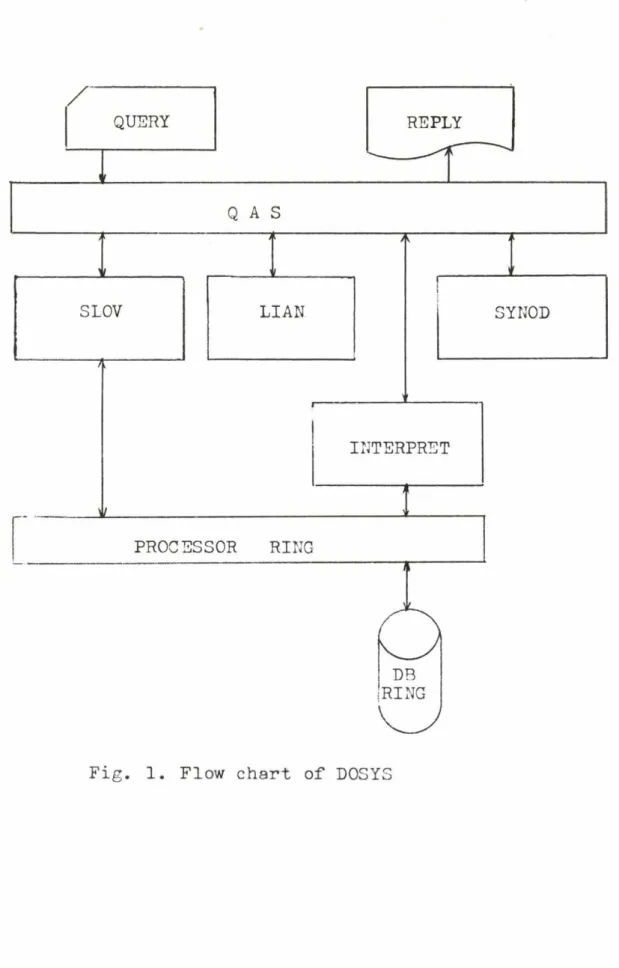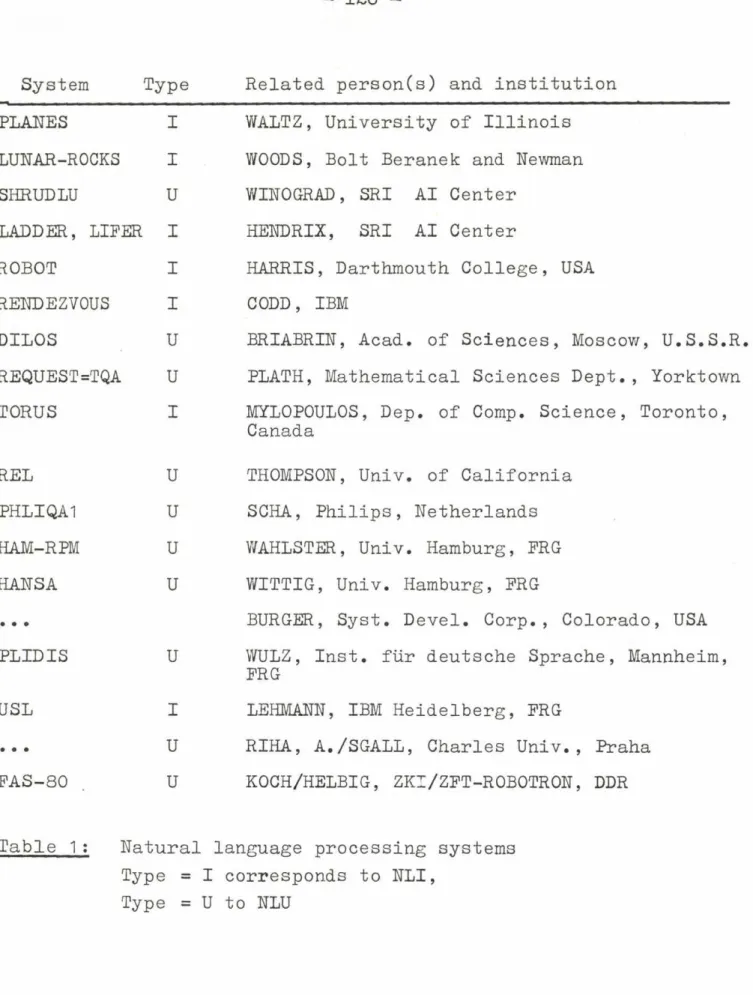MAGYAR TUDOMÁNYOS AKADÉMIA
SZÁMÍTÁSTECHNIKAI ÉS AUTOMATIZÁLÁSI KUTATÓ INTÉZETE
р г - п / : а ш т
"СИСТЕМЫ У П Р А В Ж Ш MA. И,III JiAIÏÏILK И
jIIOOPIIA
í П) r/'TTV p ГГ. TilС Б О Р Ы И К
нотно-лссэдо.
.
а т м а ь с п ы:
p a c o tТОМ I I I
Tanulmányok 133/1982
DR VÁMOS TIBOR
ISBN 963 311 Î38 2 ISSN 0324 2951
Főprint nyomda 82029
A H И Е С О Д Е P ж
Сборник научно-исследовательских работ рабочей группы РГ-П,КНВВТ
выпуск 131 - том I
Предисловие
7
Александров, А.П.
Проблемы создания вычислительных центров коллективного пользования в Комитете по
Единой системе социальной информации II Барнев, П., Кр. Марков
Проблемы управления в системах информацион
ного обслуживания коллективов 15
Батурина, Л .H., Н. А .Лепешнский
Имитация работы сетей ЭВМ 25
Бельке,3., X .-Д. Хартманн, Б . Лойхт
Автоматизированная система классификации
систем управления базами данных (СУБД) 31 БояновД.Л., В.С.Гетов, Х.А.Турлаков
Высокопроизводительные параллельные процес
соры с сетевым программированием 39 Денев,.АД., Е.К.Еивкова, Р.П.Лесева
Средства форматированная 53
Добрев,Д.М., Р.К.Киркова, П.А.Парванов
Система планирования и учета вычислительных
ресурсов 57
Добрев,Д . 1,1., Л.В. Швертиер
Доступ к записям в С У Щ БИСЕС 63 Жечковски.В.
Язык манипулирования данными
системы управ
ления
базой данных linda67
Запев,В.
Концепции и модель распределенной системы
информационного обслуживания коллективов 79
- 4 -
Златарова,!.
Эквивалентность моделей даш-шх в расспреде-
ленных базах данных 89
Клркова,Р.К.
Применение шююрмациоиных систем при орга
низации научных мероприятий
99
Киркова,Р.К.
СОКРАТ - Система для оперативного котроля над реализацией и отчетом заграничных слу
жебных командировок Ю 5
I Кондратьев, А. П.
Подход к построению математической теории
для классов информационных систем ш Списк мероприятий PP-II "Системы управления
базами данных и информационные системы" 123 Игле на и адреса участников Р Г - П 125
выпуск 132 - том II Кузнецов,Е.П.
Некоторые вопросы обработки информации в ус
ловии!': ВЦКП СО АН СССР 7
Ласкин,Л . 5., В . Н . Бе зряков
Об использовании мини-ЭВМ в системе ВЦКП 21 Лпбл,П.
Базы данных и их назначение в процессе сбора
и обработки информации
31
Марчук, Г . И ., 0.В .Mo ская ев
Проблемы и эволюция вычислительных центров
коллективного пользования
39
МетляевЦО.В.
Технические средства ВЦКП СО АН СССР
49
- 5 -
Радулов,II.P., л.Л.Владиков, К.Т.Каляева
Об одпогл по,уходе при включении вдфрового терг.тгшала КЗОТ 3500 в системы коллектив
ного пользовашш 59
С авшшов,В. К., 0.3,Беннеров, Î.Î, С. Базаров, А. Л. .Александров Обобщенные процедуры логического проекти
рования баз данных и уточнения иною логи
ческой модели: формальный подход 67 Стогний,А. А., А.И.Кондратьев
О построении математического аппарата для описания процессов проектирования и функ
ционирования информационных систем 83 ТерзиевД.И.
Управление формата отчетов и поиска инфор
мации в базах данных вычислительных систем
с множественным доступом 97
Швертнер.К.В.
Защита коректности данных при вводе в СУБД
БИСЕС 105
ШвертнерД.В., Л.Манасиев
Системный журнал в СУБД БИСЕС III Эскенази,А.М., Н.Н.Манева, В.Т.Петрова
Поиск при помощи инвертированных файлов в
системе БИСЕС II7
выпуск 133 - том III
Barnev,P., At.Radensky, P.Azalov, К г .Markov,Z.Vassilev A local information station - Version one 7 Benczúr,A.
Problems in modelling of data base per
formance 27
Bittner, J.
DBS/R - A system of practice 43
Logical dependencies in Relational
Data Base 5 9
Kerékfy,P.
Some remarks on statistical data
processing 79
Havel,I., P.Liebl
A relational DBMS in Concurrent PASCAL 99
Riha,A,
Modifiable query system for casual Data
base user J J J
Werner,”/., D.Koch
Natural language interfaces to Data
bases: a day-dream or a realistic goal? J23
MTA Számítástechnikai és Automatizálási Kutató Intézete, Tanulmányok 133/1982 Proc. of R G -ll.K N V V T
A LOCAL INFORMATION STATION - VERSION ONE
P.Barnev,A t .Radensky,P.Azalov,Kr.Markov,Z.Vassilev Institute of Mathematics with Computer Center
Bulgaria 1090-Sofia, P.QBox 373
ABSTRACT
The paper is an introduction to the command language of the Local Information Station - 1 database system. An extensive set of examples is used to describe the action of each command. Appendix 1 contains a list of all system commands.
0. Introduction
The family of local information stations (LIST) is based on the concept of information servising, developed by P. Barnev and collaborators at the Institute of Mathe
matics of the Bulgarian Academy of Sciences /1-9/.
LIST-1 is the smallest and simplest for use system of the LIST family. It is designed to manage a tabular set of data for a single user.
LIST-1 features simple use and a powerful set of da
tabase operations.
LIST-1 :
- runs on a SM-4 minicomputer;
- creates, accesses and maintains the user's database;
- interacts with the user via a terminal using a sim
ple command language ;
- allows the advanced user to define new commands as
sequences of commands as a tool for system adaptation to the specific user requirements.
1. Primaries
1.1. An exemplary database
Throughout the command descriptions we are going to use an example of a simple database consisting of 2 tables, or relations:
- a relation named ’theaters’ with attributes (columns)
’name', 'head' and 'year of foundation',
- a relation named 'actors' with attributes 'actor na
me' and 'theater'.
NAME HEAD YEAR OP FOUNDATION
National theater Dimov 1890
Drama theater Raev 1902
Comedy theater Michailov I960 Theater of the smile Ivanov 1927 Puppet show theater Tassev 1934 Ballet and show theater Malchev 1893
Army Theater Penchev 1948
Example 1.1.1 Relation 'theaters' .
ACTOR NAME THEATER
Michailov Comedy theater
Kolev Army theateT*
Markov Theater of the Army
Panova Theater of the smile
Dimov National theater
Goranova Drama theater
Jekova Show theater
Example 1.1.2 Relation 'actors'.
__ ■'. _
1.2. The database structure
The user views the database as a collection of rela
tions (tables with fixed number of columns and variable number of rows). Each individual fact is represented in the database as a row (tuple) in a relation, consisting of as many elementary data items as are the attributes (columns)
of the relation. A relation may have zero or more tuples and at least one attribute, liâmes are used to refer to both relations and attributes.
All elementary data items are character strings of any length. In case a string has several leading digits it is considered a numeric data item which evaluates to the decimal number»represented by the leading digits of the string.
$28.5 -13*588 .57 58% 147CR ©456.70 Example 1.2.1 numeric data items.
All other elementary data items will be called non
numeric or text ones.
E-10 London W1 TEXTtext POB 373 SofialOOO Example 1.2.2 Text data items.
1.3» Comparing elementary data items
Numeric data items can be tested for conditions such as equality (=), not-equality (/=), less than ( ^ ), less or equal ( ^ =), greater than ( > ) and greater or equal
( > =).
58% > 97tons, 147 parts = 147 cows, $ 9 »00 = £9«
Example 1.3*1 A H tests evaluate to ’true*.
Non-numeric data items can be tested for the same con
ditions. In the lexicographic order of characters the let-
ters follow the blank character, the digits and the special characters •
Dimov<CRoev, Mark <. Markov, LIST-1 = list-1 Example 1.3»2 All tests evaluate to ’true'.
When comparing two data items, LIST-1 attempts to treat them as numeric and compare their values. In case of failure character string comparison is performed.
1.4. Pattern matching
LIST-1 provides for the matching of a data item, trea*- ted as a character string, against a pattern. The operation is denoted ’? ’ .
The pattern is composed of character string and seve
ral special characters - T* f,T& * ,* |* ,*/T . A data item mat
ches a character string pattern iff they are equal. A data item matches the concatenation of two patterns iff it can he subdivided into two strings which match the first and se_
cond pattern strings respectively. Any data item matches the special pattern »*’.
Theater of the army ? T*y Theater ? *t*e*
Army Theater ? *T*a*t*'
Example 1.4.1 All the above matches evaluate to ’true’.
Composite patterns may be constructed using pattern concatenation and the logical connectors and (&), or (|) and not (/). Formally, a string matches the pattern P1 & P2 iff it matches both P1 and P 2 . A string matches P1 | P2 iff it matches either P1 or P 2 . A string matches / P1 iff it does not match P1 .
- II -
Army theater ? Army* & *theater Army theater ? *theater* | *army Comedy theater ? *theater* & C*
Example 1,4.2 All tests evaluate to ’true'.
D & V
*D & *V
*D* & / *D*
Example 1.4.3 The above patterns will not match any string.
1.5» Querying the database
To access the elementary data items stored in a LIST-1 database the user has to identify the relation, tuple and attribute of the specific data item. Relations and attribu
tes are referred to by their names. The specific tuple is identified by specifying a condition on the values of its attributes. The condition may be a simple comparison or pat
tern match between attribute values or an attribute value and an elementary data item (constant). In the former case, when attributes of different relations are involved, the only comparison allowable is equality and the operation is denotes Composite conditions may be constructed by using the logical connectors &, I , and / . Parentheses are
also allowed.
A condition identifies all tuples of the cartesian product of the relations concerned, for whose data items the condition test evaluates to ’true1 .
(head = Penchev) & (name ? *Army*) (name ? (A*t* I T*army))
(year of foundation>= 1900 & year of foundational 940) (head :=: actor name)
12
1.5.1 All conditions are valid for LIST-1. All Lut the last are over the 'theaters’ relation and the last one concerns both relations of the exemplary database•
1.6. Communicating with LIST-1.
The interaction between a user and LIST-1 is done via a terminal. The user specifies his intentions by issuing LIST-1 commands. The system can help the user by prompting for additional information it needs and by sending warning and error messages. A 'help' facility is also available to give the user all necessary information on system commands.
The inexperienced user may leave the initiative comple
ts,
tely^LlST-1 by specifying only the command codes. LIST-1 will question him for all additional information it needs in an easy to understand manner.
1.7» LIST-1 commands
The commands of LIST-1 comprise three principal groups:
basic commands, macro facility commands and service commands.
2. Basic commands of LIST-1.
2.1. Creation of tables and insertion of tuples. Here are some examples of these commands:
ENTER COMMAND:
121
ENTER TABLE NAME:
theaters
ENTER COLUMN NAMES:
n a m e ,h e a d ,year of foundation ENTER COMMAND:
Example 2.1.1 Creation of table 'theaters'.
- 13 -
ENTER COMMAND:
121
ENTER TABLE NAME:
actors
ENTER COLUMN NAMES:
actor name, theater ENTER COMMAND :
Example 2.1,2 Creation of table ’actors'.
ENTER COMMAND:
1 3 0
ENTER TABLE NAME:
theaters NAME :
National theater HEAD:
Dimov
YEAR OF FOUNDATION:
1890
TUPLE ENTERED:
130 NAME :
Drama theater HEAD:
Raev
YEAR OP FOUNDATION:
1902
TUPLE ENTERED:
013
ENTER COMMAND:
Example 2.1.3 Entering 2 tuples in the 'theaters’ relation.
In order to create a tatle, the user has to specify its name and the names of all attributes as parameters of command 121. Command 130 is used to enter (insert) tuples in an existing relation.
The experienced user can follow the ’fast path’ by issuing a 230 command instead of a 130.
230 - table (theaters)
~ columns (name, year of foundation, head) - tuples (National theater, 1890, Dimov;
Drama theater, 1902, Raev;
Comedy theater, I960, Michailov)
Example 2.1.4 Using command 230 to enter tuples in the 'theaters’ relation.
In case the database contains two relations with si
milar attributes, the relations may be linked together by inserting the tuples of one of them into the other (command 231).
2.2. Deletion from the database Here is the next example:
ENTER COMMAND : 160
ENTER TABLE NAME : actors
ACTOR NAME : Jekova THEA T E R :
♦show*
TUPLE DELETED:
013
ENTER COMMAND:
Example 2.2.1 Deleting tuples from a relation.
- 15 -
ENTER COMMAND:
160
ENTER TABLE NAME:
theaters NAME :
YEAR OF FOUNDATION:
TUPLES DELETED:
013
ENTER COMMAND:
Example 2*2.2 Deleting all tuples of a relation.
ENTER COMMAND:
151
ENTER TABLE NAME : theaters
TABLE DELETED:
ENTER COMMAND:
Example 2.2.3 Deleting a table from the data^g- The above examples illustrate the use of commands 160 and 151 - tuple and table deletion. When promted with a co
lumn name in the 160-command intercourse the user is expec
ted to specify a simple condition on the value of the со - lumn. The default condition is * ? * * (see Example 2.2.2).
2.3 Update commands
The LIST-1 tuple update commands will be illustrated by the following examples:
ENTER COMMAND:
170
ENTER TABLE NAME:
theaters NAME:
16
Ballet and show theater HEAD:
YEAR OP FOUNDATION : UPDATES :
NAME:BALLET AND SHOW THEATER HEAD: MALCHEV
Kalchev
YEAR OF FOUNDATION: 1893 /0
TUPLE UPDATED:
ENTER COMMAND:
Example 2.3.1 Updating a tuple.
ENTER COMMAND:
270 - table (theaters)
- condition (name = Ballet and show theater) - columns (head, year of foundation)
- tuples (Kalchev,/0) TUPLES UPDATED:
ENTER COMMAND:
Example 2.3.2 Update a tuple - the fast path.
To update the elementary data items in a relation on uses the 170 LIST command (see Example 2.3.1) or the 270
command (see Example 2.3.2). The data item value ’/0* is a notation for the ’unde-fined* value.
2.4 Information retrieval We begin with examples again:
ENTER COMMAND:
144
ENTER TABLE NAME:
theaters
NAME:
- 17 -
HEAD:
YEAR OR FOUNDATION:
^ = 1900 THEATERS.
NAME HEAD YEAR OF FOUNDATION
NATIONAL THEATER DIMOV 1890
BALLET AND SHOW THEATER ENTER COMMAND:
MALCHEV 1893
Example 2.4.1 Retrieving tuples from a LIST-1 relation.
ENTER COMMAND:
244 - table (theaters) - columns (actor name)
- condition (theater ? ( A * r | * army *) ) ACTORS.
ACTOR NAME KOLEV
MARKOV
ENTER COMMAND:
Example 2.4.2 Retrieving specified columns of a relation - the fast path.
All query commands require the specification of the relation (table) name, the requested attributes' (columns) names and a condition identifying the tuples to be retrievéd.
If the condition test evaluates 'true* for all tuples of the
18
relation, all tuples will Ъе displayed«, Two-table queries are also possible •
ENTER COMMAND:
243 - tables (theaters, actors) - columns (head)
- condition (head :=: actor name) HEAD
MICHAILOV DIMOV
ENTER COMMAND:
Example 2.4.3 Retrieving the names of all actors that are theater heads.
Such queries may be viewed as ranging over the carte
sian product of the relations involved.
3. Macro facility commands
LIST-1 allows for the definition of new commands as sequences of system commands. The user-defined commands will be called 'procedures’ .
ENTER COMMAND:
200 - name (create)
- parameters (tab,col)
- body (121 - table (tab) - columns (col) ) ENTER COMMAND:
create - tab(actors) - col(actor name, theater)
Example 3.1 Definition and usage of a 'create' c oramand.
The parameter passing is done by direct replacement of character strings in the procedure body.
The command 201 is used to delete a user defined pro
cedure
-
19
-ENTER COMMAND:
201 - name (create) PROCEDURE DELETED:
ENTER COMMAND:
Example 3«2 Procedure deletion.
Default parameter values may also be defined in a p r o cedure definition. A procedure may invoke other command p r o cedures, but no recursion is allowed.
4. Service commands 4.1. Indexing
To decrease search time LIST-1 provides for a special mechanism, called 'index', on columns of tables that parti
cipate in the search argument. The index, if present, will automatically be used to speed up all searches involving the indexed column (attribute). When created or destroyed indi
ces are identified by names. The user can define indices where the values of the column are ordered either up or down,thus defining the order of tuples in all retrieve or update operations.
ENTER COMMAND:
125
ENTER INDEX NAME:
years
ENTER TABLE NAME:
theaters
ENTER COLUMN NAME : year of foundation INDEX CREATED:
ENTER COMMAND:
Example 4.1.1 Index creation.
ENTER COMMAND:
155
ENTER INDEX NAME:
years
INDEX DESTROYED:
ENTER COMMAND:
Example 4.1.2 Index destroyal.
4.2. Getting general information about the database The u s e r may request information about the tables in the database (command 141) and their columns (command 142).
The number of tuples in a relation whose attribute values fulfill a given condition may also be displayed (246 and 247 commands) .
ENTER COMMAND:
142
ENTER TABLE NAME:
theaters
COLUMNS OP TABLE THEATERS:
HE AD, NAME, YEAR OP FOUNDATION
HTDICES OVER COLUMNS OP TABLE THEATERS:
YEARS OVER YEAR OP FOUNDATION ENTER COMMAND:
Example 4.2.1 Displaying information about a tab
le in the database.
4.3 Messages
The advanced user may want to change the LIST-1 sys
tem messages. LIST-1 provides 2 commands - 280 and 281 for sending user messages to the terminal and changing system messages respectively.
- 2 1 -
ENTER COMMAND:
200 - name (русский)
- body (281 - oldmsg (ENTER COMMAND:) - newmsg ( ЗАДАЙ КОЫАЬЩУ : )
280 - msg (ДАЛЬНЕ ДИАЛОГ БУДЕТ НА РУССКОМ ЯЗЫКЕ; )) ENTER COMMAND:
русский
ДАЛЬШЕ ДИАЛОГ БУДЕТ НА РУССКОМ ЯЗЫКЕ;
ЗАДАЙ КОМАНДУ:
Example 4*3*1 System message change.
4*4* Interfacing to the operating system
LIST-1 allows for directly sending commands to the operating system (command 222). A LIST-1 command file execu
tion is also possible by using command 221. Command 220 is used to redirect the LIST-1 output to a file, instead of the user's terminal.
Activation and deactivation of LIST-1 depend on the specific operating system. Command execution may be termina
ted by responding ’0 1 3 ’ to any LIST-1 question.
5. Concluding remarks
The main requirements to the implementation of LIST-1 are :
- portability;
- small main memory requirements;
- reliability and simple use.
Portability is achieved by using FORTRAN as the imple
mentation language and by programming LIST-1 as a complex of small modules. System modularity also keeps the main stora
ge requirements relatively small. Reliability is achieved
by using proper protection machanisms•
The LIST-1 database is implemented as a complex lin- kedjiist structure - a decision imposed by the requirement that an elementary data item may be a string of any length.
Appendix 1
LIST-1 command syntax 1 . Basic commands
1.1. Table creation commands
1.1.1. Including a table in the database 121 - table (table name)
- columns (column name £,... column name n j ) 1.1.2. Inserting tuples in a relation
230 - table (table name)
- columns (column name 1 [ , ... column name nj ) - tuples (column item 1 [_ »...column item n j
[;... column item 1m [, •. • column item nmj]) 130
1.1.3* Combining two tables 231 - object (table name)
- source (table name) 1.2. Deletion commands
1.2.1. Table deletion
151 - table (table name)
1.2.2. Deletion of tuples from a table 260 - table (table name)
- condition (condition expression) 160
1.3* Update commands
1.3.1* Updating tuples in a table 170
270 - table (table name)
- condition (condition expression)
- 23 -
- columns (column name 1 [ »...column name n]) - tuples (data item [»...data item nl [" ;...
data item 1m f,...data item nnQ 3 ) 1.4. Information retrieval commands
1.4.1. Tuple retrieval from a single table 244 - table (table name)
- columns (column name 1 £,...column name n 3 ) - condition (condition expression)
144
1.4.2. Tuple retrieval from 2 tables
243 - tables (table name 1,table name 2)
- columns (column name 1 £»••• column name n J ) - condition (condition expression)
2. Macro facility commands
2.1. Definition of a command procedure 200 - name (procedure name)
- parameters (paraml Г»**, param n ] ) - body (commandl [",... command m J ) 2.2. Deleting a command procedure
201 - name (procedure name) 3. Service commands
3.1• Indices
3.1.1. Index creation
126 - index (index name) - table (table name) - column (column name) 127 - index (index name)
- table (table name) - column (column name) 3.1.2. Index destroyal
155 - index (index name)
3.2. Getting statistical information 3.2.1. Database tables list
141
3.2.2. Table description
142 - table (table name)
3.2.3. Number of tuples in a table (or cartesian product of tables)
246 - tables (table name 1, table name 2) - condition (condition expression) 247 - table (table name)
- condition (condition expression)
3.3. Messages
3.3.1. Sending a message to the u s e r ’s terminal 280 -msg (message text)
3.3.2. Change of a system message 281 - oldmsg (message text 1)
- newmsg (message text 2)
3.4.
Interface to the operating system3.4.1. Redirecting the system output to a file 220 - command (command text)
- file (output file name) 3.4.2. Command file execution 221 - file (command file name) References
1. P. Baraev, Système abstract de service informatique des collectivites, Congres de mathématique appli
quées, Thessalonique, 1976.
2. P. Barnev, Systems for information servicing of collectivities, Serdica, vol. 4, fasc 2-3, 1978.
3. P. Barnev, At. Radenski, Structure of the informa
tion and operations on the entities in a system for information servicing of collectivities, Ser
dica, vol. 4, fasc 2-3, 1978.
- 25 -
4. К. Ivanov, Concretization of the collectivity and individualizing the communication language in a system for information servicing of collectivities, Serdica, vol. 4, fasc 2-3, 1978.
5. П.Бърнев,К.Иванов, Входыо-изходна система за инфор
мационно обслужване на колективи, IY Мелдународный симпозиум по передачи данных и обработке информации, 26-31 мая 1977, Варна.
6. П.Бърнев, Вл. Занев, Ат. Раденски. Бази от данни.
Система за информационно обслужване на колективи.
YIII Пролетна конференция на СМБ, Сл. бряг, април 1979.
7. П.Бърнев,Ат. Раденски, Вл. Занев, Структуры данных в архиве системы информационного обслуживания кол
лективов, Сборник докладов конференции по приложе
нии вычислительной техники и баз данных в научных исследованиях, Варна, май 1978.
8. Вл. Занев, Концепция и модель распределенной сис
темы информационного обслуживания коллективов, Сборник докладов конференции по ВЦКП, Елагоевград, 1979.
9. П.Барнев, Кр. Марков, Проблемы управления в систе
мах информационного обслуживания коллективов, Сбор
ник докладов конференции по ВЦКП, Благоевград,1979.
MTA Számítástechnikai és Automatizálási Kutató Intézete, Tanulmányok 133/1982 Proc, of RG—11, KNVVT
Problems in modelling of data base performance András Benczúr
Data base systems have some special properties which make the modelling of their performance more difficult than that of computer systems. First we analyze these properties as differences from the models used in the theory of operating systems and from the mathematical model developed for
information transmission. Then a new model - something like a conceptual data model - is proposed to describe the back
ground of a data base; and, on the basis of this model, the main problems of data base performance are stated.
1. Special properties of data base systems
As it is shown in Fig.l, a Data Base System /DBS/ is inside a Computer System /CS/ which serves the information needs of an Information System /IS/.
A given realization of this information service uses certain parts of different CS resources. The theory of operating systems deals with the problem of the efficient use of these resources as a problem inside the C S . How we can decrease the amount of the used CS resources by better organization - this is the problem of CS performance. But the performance measures used in the evaluation of CS performance give no
answer to the question how efficient our solution, i.e. our DBS, is from the aspect of the IS. It may happen that our solution requires a lot of data preparation work from the I S , e g. high redundancy in input, as it is typical in the case of independent batch subsystems using own files. This means that the IS must invest information work into the DBS, and
I name this information investment. Having the "most efficient"
solution of our DBS problem from the aspect of the CS, the decrease in information investment will result in a new DBS using more recources than the former one. This situation is illustrated in Figure 1.
So, the performance of a DBS is not only the problem of the efficient use of CS resources but that of an efficient
information service as well. We cannot investigate this problem without a measure of information. This measure has to be defined on the information /or data/ model of the real world represented by the DBS. Data models developed in the last two decades are not capable of measuring information, they are oriented either to data manipulation purposes /e.g. file-systems, relational, hierarchical, and network data models/ or to knowledge repre
sentation /e.g. the proposals for conceptual data model/.
It is quite obvious to ask whether the measures and techniques developed on the basis of Shannon's entropy concept can be used or not. We have two problems when we try to describe the
functioning of a DBS on the analogy of the information trans
mission model. The first one is that we have no background probability space where the information comes from. Our back
ground space is not a mathematically well-defined one, the source information comes from a real "living" organization, so the background space is a continually developing, open system.
The second problem is that the coding in the information theory is just the opposite of the coding in data bases. The classical coding theorems are concerned with coding and decoding signals /or finite series of signals/ coming in a sequence according to some probabilistic rule,/e.g. independent series, Markovian series etc./.
In a data base there is a very large c o d e ^ h e stored data. We have to change this code according to relatively small pieces of information /coding input data/ and we have to decode
some part of this code according to planned or ad-hoc information request /coding output data/. This situation is shown in
Figure 2. On this simple sketch, the source information is added to the stored data through an input coding system, and the
answers to information requests are derived from the stored data by an output coding system. But we cannot say a DBS works like a data transmission channel with very large but finite
- 29
memory, because the output code is not the simple transmission of the source information, it is s t i m u l a t e d rather by the
questions than by the source.
In order to clarify the role of the DBS further, we have to explain the role of the IS from a new point of view. As it is shown in Figure 3, an IS has two interfaces to the real world of the organization it is serving.One of them collects and makes managable facts about the objects constituting the organization. The set of these facts is the knowledge of the organization about itself. I call the corresponding interface the Information Elaboration System of the IS.The second inter
face understands the requests for information, and makes under
standable the requested information for the requester, that is, it gives back an answer. I call this interface the Question and Answer Formulation System. The part of the organization where the requests arise I simply call the Information Using System. It covers, among other things, the decision system, or the operational systems of the organization.
The possible set of requests is denoted by Questions. Each question is connected to some part of the Knowledge, and the IS can determine the answer to the question from this infor- mation. The flow of information is the following:
the Q-A Formulation interface receives and understands the request, and through the IS, the question is connected to a
part of the Knowledge. This part is not only accessible through the Information Elaboration Interface, but the answer can be determined from it as well. The answer is made understandable for the receiver by the Q-A Formulation interface. Naturally, some actions of this flow can be done in advance, and this is always true when the IS uses a CS.
One possible model for the information flow through the CS is also given in Figure 3.
2. Proposal for the background space of the IS:
the Knowledge Space
The basic problem we have is to find a model which can satis
factorily play a similar role as the probability space does in Shannon's information theory. Since the probability space gives a total model of the information source, our model has to be a total model. Totality means that the model has to reflect the continually developing and growing self-knowledge of the organization. Before building up the model, that is the К-Space, we have to recall Fig.3. We only deal with items of knowledge which are accessible by the IS, that is, which are identified by means of formulizing a question. So a
question is nothing else than the identification of a piece of knowledge, /or in other words, it is an entry point into the К-Space/, and the answer is the information contained in this information relevant for the receiver. While the K-Space
contains total information, an answer is always limited: it gives only the relevant information. The three components
mentioned below: a question, an answer and a piece of knowledge /or information/ make up a unit in the K-Space.
From another aspect, we can also say that a piece of knowledge corresponds to certain facts about an identifiable object in the real world. /This object can also be an abstract one, or a possible one and so on/. A question identifies both an object and the relevant facts about it. But the IS does not know the objects, it knows only the items of knowledge, and there is a one-to-one mapping from the set of objects to the set of
accessible items of knowledge. So the structure of objects is reflected by the structure of accessible parts of knowledge.
This structure contains not only natural but artifical aspects as well. The IS can identify the elements of this structure, that is,the parts of knowledge corresponding to the objects identified by the questions. From these parts of knowledge, the IS gives the answers like a filter. Figure 4 gives an illustration of this.
- 31 -
Let us turn to the definition of the K-Space.
Def .1. A threefold, /Q,A,I/ is called a К-element, where Q is a question, A is an answer and I is some information. The answer A is derived from I according to the question Q, so the pair Q and I completely determines A.
Def.2. A К-State "K. is given by the sets 0 - ( Q;l • iÁ ~ ( •
--- f T Г L =
L
^and Y= \ as the set of К-elements У \ = )(.
The set 0 is the set of different questions, that is
Q; * Qj i-f ; # i .
уД is the set-of answers, and Y is the system of K-parts, which are the identified parts of the knowledge. For the sake of simplicity, we suppose, that both Q^and A ’v are contained in 1^, and A^, being the actual relevant information, is
accessible by Q^. A К-part may contain another К -part, but the IS does only know it if it is embedded as a K-element.
/See operation 2./
Def .3. A sequence of К-States is a К-Space, if each state is generated from the previous one by one of the two operations given below. This means a К -Space is a monotonous increasing sequence of K-States.
Operation l .The addition of new information:the growing operation /G-operation/.
Let IRew be a piece of information which is going to belong to or form a К-part identified by Q. This means, some new infor
mation is added to the К-state through the entry point Q.The result is a new К-part with a new answer and its K-element contains the previous K-element.
We use the following notation
/1/ ~ (Ö,
in the case when the K-element /Q,A,I/is growing.
Remark 1 The notation
I + I
v\iW means that the new К-part contains both the old and the new information, but they are not accessible separately.Operation 2 The embedding of a К-element into a К-part: the embedding operation /Е-operation/. When a new piece of infor
mation means that a part of knowledge is a subpart of another one and both of them are identified by a question, than the former one is embedded into the latter.
и с о H i o -f r-i "M n u i nrr nn+- д -t- i n n c i i m i l s r -ho / "I /
Where is the identifier of the embedded К-part and I is the embedding information that shows the role of the K-part identified by Q and determines the way of giving the new answer.
The structure of the К-space is developed by E-operations. The following rules show the main features of the embedding:
We use the notation or simply Qi ^
if Q-^ is embedded into
Rule 1 Let
I J
be embedded i that is Q 4£_I. If some new information , I Q^, it affects the K-element О . a , r ) notational form supposingRule 1 be embedded into
is added to new
too. In
/з/ I = l' © Q, = i ' © (Q., , I J
we have
This means that an embedded К-element remains embedded in its actual state automatically, and its changes consequently change its host K-element.
- 33 -
Rule 2 It is similar to Rule 1, but changing the Q -operator in/ 4 / into an E-operator.
Remark 3 Since there are no restrictions given for E-operations, a К-state may have a very complicated structure full of deep recursion. Rule 1 and Rule 2 do not determine the sequence of changing the host К-elements, so it is supposed that the
corresponding changes are made simultaneously. From this reason
ing it follows that the G - and E-operations rather affect the whole К-state than one of its K-elements.
Remark 4 I only want to mention here I have tried out how the К-space can reflect different data models.
3. The measure defined on the K-space
There are two aspects that mainly determine the construction of our measure. The first one is that questions, answers and information parts are understandable for the organization and each of them has an information quantity, which is necessary for understanding. This means, these quantities are different from the code lengths of an "optimal" coding.
The second aspect is that during the development of the K-space, the quantity of each К-part gets larger by the new facts added to it by a G- or E-operator according to Rule 1 and Rule 2.
Def.3 The К-measure ^ is defined on each component of the K-space, that is on each question, answer, К-part and K-element.
The measure satisfies the following conditions:
Cond.1 Within a К-state given by the K-elements
The meaning of this condition is, that questions are different,
and we also need the possibility to add new questions to a state.
Cond.2 Within a К-element /Q,A,I/ the К-part I contains both Q and A, so
x ( I ) > •*- ( Q ) and
% ( ! ) - X (A).
Cond.3 The measure of a piece of information to be added to the К-state expresses its independent content, so the measure of each К-element that contains the К -element to which the new information is added by a G-operation is increased by the
measure of the new information. According to /1/ and /3/ this means
* { ( Q , / t , i ) t ( û , I » . j ] = x (I)
L J and
if
Q
C l1X [ ( Qi Г I 1-1 ) + ^ (^i) ** ^ .
Cond. 4 The embedding of a К-element into another one increases the measure of the host only by the measure of the part of the graft that is not known by the host. So, according to /2/
if
Q1 Ф
andQ t Ф Q,
hold,(<3, , L Q i ,i*])]=x(r,)+x(Ie) i - x ( Q d t x ( i J .
And in the case when Q ,
C
Q Qj £ QX { ( q , a , I) © ( Q., t 1. , о»Л)} = X.(I) +- V-(Ie) + (Qj.).
- 35 -
After building up our measure, we can measure the work of the IS necessary to execute Q ~ or E-operations. We can
determine this work by adding all the values that express the growths of all К-elements affected by the operation.
For example, if Q is embedded in and we add
(Q, I ) to the К-state, the volume of the execution work is equal to
(k + i ) x . ( I ntJ
The derivation work of an answer in the К-element (q,A,i) is the difference (I) — ^ (/4)
Note The investigation of the properties of the K-measure has not been finished yet. It may have some weaknesses and the complexities of the structure developed by E-operations may need some measure, too.
4. Formulation of the DBS effectivity
In this last paragraph, we describe the problem of the DBS effectivity in terms of the K-space.
First we characterize the DBS as it reflects some subparts of the K-space.
The most important subpart of the K-space, which determines the DBS, consists of the set of possible questions coming from the Information Using System;
e„c e
./This type of short notation means, that, when the K-space grows, both Ö* andÔ grow./ 0 O determines the set of answers J\,Q that corresponds to the output of the DBS.
Since the answers in A Q are changed in consequence of G and E-operations, it is not suitable that the DBS should contain only answers. So we can say that the DBS contains mappings of special К-parts that are sufficient for deriving the answers.
The set of these К-parts is given by the set of questions e „ c © . The stored data do not cover the total information contained in the K-elements / Q^, A^, 1^ /, Q; £ Instead of I. the DB contains some data mapped from 1^, so that it is sufficient to derive all the answers belonging to Q., Q. £. 0 O . We can say that the system / Q ^ , D^/,
Q; e ©о gives the logical model of the stored data.
The third important part of the DBS is the system of special К-elements that are embedded in К-elements belonging to • The special property of these elements is that new information are added to them by G-operations, and they are most frequently embedded by E-operations. The system of these elements is
given by the set of questions 0j , and the new pieces of information added to them are the input of the DBS.
Now we can express the efficiency of the DBS in the following way :
The information source is given by a stochastic point process, the events of which mean the growth of the information space restricted to 0 ^ . We can associate with the events the
measure of the information growth in 0 ^ and 0 O caused by the corresponding
G
- or E-operation. The expected average value of this information growth can be treated as the source capacity.The stored information /the content of the DB/ can be measured as a part of the information space. An upper bound can be
given by adding the values ^ (li) when o ( £ ©o . This upper bound corresponds to the solution of highest redundancy.
This upper bound karacterizes the necessary storage capacity.
The third capacity corresponds to the stream of questions coming from the Information Using System.
This capacity can be given similarly to the input capacity: a stochastic point process describes the occurrance of questions,
and the value of oc(Qi) + * ( A i) is associated to the events of the process. Maybe it is useful to separate the
measure of questions and that of the answers, because question coding and answer derivation may use different processes.
These capacities require different computer system resources, /extended sometimes by human power of different computer -
specialists/. Efficiency is: to use fewer and cheaper resources to assure the same capacities. The most interesting point in this problem is the complicated conflicts among the capacity demands in using computer-system resources. For example, the more recources are used to update the data base code by the
input, the fewer recources are needed to meet the output demands.
used resources of CS
decrease in Information Investment
extra resources corresponding to decreased Information Investment
Figure 1
- 39 -
IfJFOÍl H Á T I O N sySTEr?
1 C O M P U T E R S Y S T E M 0
p .!.-U
и P ..
T U
c S T O R E D d a t a; { T 0
0
1
' V ,
V
c
hl !
V
G 0
Figure 2
S 0
К
R С É
I К/ F O Я П А Т I O U S Y S T E - M
С& П
РИ ТЕР Í y'STÊ
14SS/mCHtA/Ç_^
1
W1
а
D f\TА !
ел-se/
_____ S E _
G^.Reco u-, KJlf'l CW Ou t p u t
c o ù j j j j^ * А К / Ш В Л ^ Ь В Ш Ш !
Figure 3
- 41 -
Figure 4
MTA Számítástechnikai és Automatizálási Kutató Intézete, Tanulmányok 133/1982 Proc. of R G -1 1, K N W T
DBS/R - A SYSTEM OF PRACTICE JÜRGEN BITTNER
VEB ROBOTRON ZENTRUM FÜR FORSCHUNG UND TECHNIK
8012 DRESDEN PSF 330
1. Introduction
In the GDR since 1979 the efficient Data Base Management System/Rohotron (DBS/R) has been available. It has been developed in VEB Robotron Zentrum für Forschung und Technik
(Centre for Research and Technology) and tested together with enterprises and institutions of different branches of economy. Until April 1981, 136 buyers have purchased this system; some of these sales will include the manifold reuse in companies of whole industrial branches. Averagely at
present two to three projects per user are prepared or used.
Both databases for support of projects of the single tradi
tional fields and also highly integrated systems up to
management information systems are represented in the large number of applications. In addition to the advantages of database organization, these applications utilize the specific advantages of DBS/R for a rational projecting which permits a short-term achievement of the objects in view.
2. Short Characteristic of DBS/R Data and storing structure
DBS/R permits both on the level of record types and also of
record instances the representation of optionally extensive network structures. The main components of the structure - master and chain data - have a very high flexibility and can be adapted well to the specific logic data structure of the user. DBS/R provides this basic structure on an essentially higher convenience level than it is know, for example, by TOTAL of Gincom Systems or DBOMP of IBM. For implementation, DBS/R uses address reference, address chains, primary index, and secondary index. As to the
efficiency these techniques may be used very differentially.
DBS/R supports traditional file organizations, too, to make possible a uniform methodology for different data sets.
Data Description
A special subsystem, the Data Description Catalog (DATKAT), serves for creating and updating the data descriptions. It permits the development of a concrete data structure by steps and provides simultaneously the possibility for docu
mentation. In addition to the description of the database (files, records, segments, fields, relations between records, integrity conditions etc.), this subsystem performs the
definition of all inputs for the database as well as their allocation to the elements of the database.
Data manipulation
DBS/R has a very efficient data manipulation language. It can be used in connection with the basic languages Assembler, PL/1, COBOL (host language) and also independently on other
languages (self-contained), and is easy to learn. This
language comprises both statements with elementary services and also very complex statements. The self-contained appli
cation of the DBS/R language permits in addition to the fast formulation of inquiries and reports the design of routine programs for frequent use, too.
- 46 -
The system has statements for the access to single records and record sets of the database, for input and output of sequential data sets, the layout of lists, for comparing, for arithmetic operations as well as for the representation of favourable program structures.
The statements for creating and updating the database offer a high performance. One single statement can control here the processing of an input file which releases updatings in the total database including extensive defined checks.
Additional functions
Essential additional functions are - data privacy
- securing the physical integrity - restructuring
By means of data privacy the user organizes the protection against unauthorized use of the database system. This is performed variously according to data units of different
level, copies of data units as well as to functions and function groups. The components for securing the physical integrity preserve the user from the loss of the database or of intermediate results of programs in consequence of machine, program, or operating errors. Furthermore, they make possible the recovery of older database states.
Restructuring serves for changing the structure of the data
base, which may become necessary in the interest of an increase of effeciency or of modifications of the real problem definition. For this purpose, a special status of data description is provided for transferring the database to the new structure.
Modes of operation
DBS/R can be used both in batch processing and also in real—
time mode with teleprocessing#
Purposeful procedures support singly or together the genera
tion of programs, their storing and execution for the batch processing# Por r e a l t i m e operation the Exekutiv system is to be generated# This system controls processing of trans
actions, commands, and messages for up to 2 5 0 terminals#
Pigure 1 shows the essential components of the Data Base Management System.
General prerequisites
The system operates on all ESER systems using the OS/ES
Operating Systems from VEB Kombinat Robotron, e# g#, ЕС 1022, ЕС 1035, ЕС 1040, ЕС 1055# Furthermore, DBS/R is able to
work on systems as IBM/360 and IBM/370 with the appropriate operating systems# The Exekutivsystem requires generation of the TCAM access method#
3# Application of DBS/R 3.1. Fields of application
In the GDR, DBS/R is used in almost all branches of economy and institutions of public life# Nearly all industrial
branches work with data bases on the basis of DBS/R# The most representatives come from the enterprises and companies of the following ministries (table 1):
Table 1 : Application of DBS/R in the industrial branches of GDR
number of companies
electrical engineering/electronics 41
heavy machine and plant construction 14
chemical industry 11
general mechanical engineering, agricultural
machine and vehicle construction 9
- 47 -
number of companies machine tool and processing machines construction 27
building industry ore mining/metallurgy light industry
15 8 4
Furthermore, branches such as agriculture, forestry, food
stuffs economy, posts and telegraphs, traffic, public health, higher education, geology, culture, local authorities, etc.
are represented. Nearly all users of the branches mentioned have own computing centres. They prepare the use of DBS/R
independently by means of the normative support services of VEB Robotron ZFT.
A large number of smaller enterprises use DBS/R by means of the regional service computer centres of the GDR who have acquired the system for extensive reuse. A further increase of DBS/R application in the GDR is to be taken into account.
Also the export to the countries Hungary, Iraq, India, China, Cuba, Corea, Angola has begun. Realized projects exist in Hungary, China, and India.
The most extensive field of application at present is the technical preparation of production with about 40 to 45 % of the projects. The share of other applications such as material economy, manpower, sales, production planning, balancing, investment planning as well as of applications
in non-producing spheres increases very much. The share of DBS/R applications in technical preparation of production will not exceed, however, 25 % of the total number of applications also in the next years. First management
information systems based on DBS/R are already in use, too.
3*2« Characteristic examples
3.2.1. DBS/R in technical preparation of production
A large number of application have a database the core of
